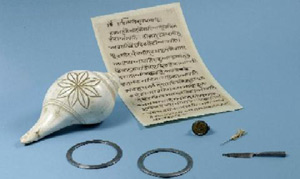
The Bhai Maharaj Singh Collection
Amongst the treasures in the collection of London's British Library, which include the Magna Carta and the Lindisfarne Gospels, lie a remarkable collection of modest personal effects that tell an extraordinary story from the dying days of Sikh sovereignty in Punjab.
These seemingly unassuming objects - two steel bracelets, a miniature dagger, a needle and thread, a conch shell and a seal ring - were the belongings of Bhai Maharaj Singh (d.1856) a spiritual leader and fervent Sikh nationalist. Now carefully preserved, they were confiscated from him on his arrest in the year following the Anglo Sikh wars in 1849.
Bhai Maharaj Singh was an inspiration to thousands of ordinary Punjabis and a thorn in the side of early colonial aspirations in the state. His power and revolutionary activities against the British during the Second Anglo-Sikh War (1848-49) prompted The Times of London to note "It is well known in certain circles that the influence of this man is unbounded amongst the Sikh chieftains and the whole population of the Punjab; and there is little doubt but that he has generally been the prime mover in all the conspiracies and revolts which have lately caused so much of the Punjab expense and led to so much bloodshed."
Shortly after the Khalsa Army had surrendered to British arms in 1849, the Bhai was ultimately arrested and quickly exiled to Singapore where he died in 1856 after six years spent in solitary confinement. He remains an important figure for the Sikh community there as well as in Punjab.
His personal possessions housed at the British Library were confiscated from him at the time of his arrest. They provide are a remarkable insight into this extraordinary Sikh leader. The pair of plain steel bracelets (kara) and the miniature dagger (dastar vali kirpan) are extremely intimate and personal items. Seemingly more mundane yet indispensable for a roving warrior is a humble sewing needle and thread. The conch shell speaks of his role as a spiritual leader. The only obvious symbol of majesty is the seal ring, inscribed in reverse Gurmukhi script with the invocation: "Akal sahai Maharaj Singh ji" literally The Immortal One protects: Maharaj Singh ji.
"These objects are of international importance to anyone interested in Sikh heritage." commented Jennifer Howes the British Library's Curator of Art Objects in the Asia Pacific and Africa Collections, who researched the collection of objects and oversaw their conservation "Preparing online catalogue entries for them has been a real honour. I am pleased that the full story behind these exceptional items is now available to researchers worldwide."
The objects and the manuscripts were in the British Museum's collection since the 1920s when they were gifted to the institution by a direct descendant the man who finally arrested the Bhai in Jalandhar. "The items have been in secure storage, alongside the rest of the India Office Collections, ever since they were received. The bracelets, kirpan and ring are in absolutely pristine condition. You could still use the needle and thread today, and I'm sure if blown into, the conch would still make its distinctive sound,"
But these aren't the only artifacts connected with the Sikh holy man in the vaults of the British Library. Four of his personal manuscripts handwritten in the Gurumukhi script complete the collection. These have been catalogued in detail as a part of a national project to catalogue Punjabi manuscripts in UK national collections undertaken by United Kingdom Punjab Heritage Association (UKPHA). Its senior cataloguer, Harminder Singh Mann, commented on their significance: "These four manuscripts range from a single page to a short anthology " each one gives important clues into the life of one of the most enigmatic of characters from Sikh history." Mann also told Punjab Heritage News that "the meticulous conservation of these precious manuscripts by the British Library means that they will be enjoyed and studied by for many generations to come.
Bhai Maharaj Singh was born Nihal Singh in Rabbon, Ludhiana. In his early life he came under the influence of Bhai Bir Singh of Naurangabad and succeeded him on his death in 1844. By this time he was already an influential religious leader in the Sikh courts of Lahore. At a time of growing British influence and interference at court, his message was uncompromising and highly nationalistic. His transformation to saintly revolutionary was completed in 1847 when he was implicated in a conspiracy to assassinate Henry Lawrence, the British resident at Lahore. With his property confiscated and wanted by the British he went underground with 600 followers in order to continue his sedition. The governor-general at the time, Lord Dalhousie, offered a staggering Rs. 10,000 bounty for his head.
The British eventually caught up with Bhai Ji at the end of 1849. In an armed standoff Henry Vansittart and twenty cavalry irregulars arrested Maharaj Singh in the Jalandhar district. Vansittart summed up the British attitude towards the Bhai's influence and their utter frustration at his continued subversion in the following statement: "The Guru is no ordinary man. He is to the natives what Jesus is to the most zealous of Christians. His miracles were seen by tens of thousands and are more implicitly believed than those worked by the ancient prophets." Further proof of Maharaj Singh's influence was evidenced in this report from The Times of London: "whilst he is revered by all the parties and ranks for his supposed power of working miracles, and is, in fact, the one holy man and prophet of the Punjab."
Within days of his arrest the Punjab was in turmoil; a plot to break him out of prison was feared and six Akali Nihang followers launched a suicidal raid on a British army cantonment in Lahore.
A swift execution was out of the question for fear of igniting a mutiny or a guerrilla war. With incredible rapidity, the British authorities made hurried plans to exile him to the notorious Outram Road Jail in colonial Singapore. It was in the stinking confines of Outram Road that Bhai Maharaj Singh lived out the final six years of his life. He died 1856 and the place of his cremation was marked with a stone slab.
Even in death his legend lived on. Native Tamil and Chinese people of Singapore came to the cremation site to worship at his samadh (funerary stone). In 1966 this stone was moved to the Silat Road Gurdwara on the island.
For the full catalogue entry click here
Written by Amandeep Madra and Parmjit Singh
Monday, 30 June 2008

